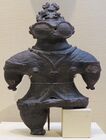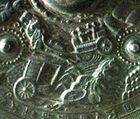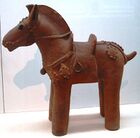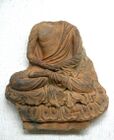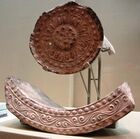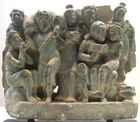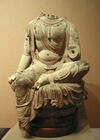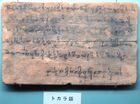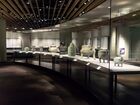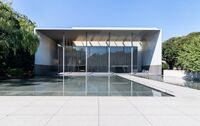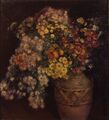متحف طوكيو الوطني
東京国立博物館 | |
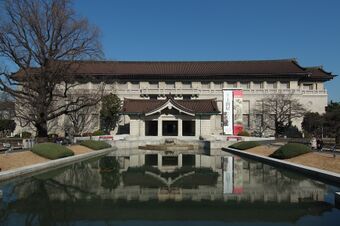 The Honkan (Main Gallery) | |
 Interactive fullscreen map | |
| تأسس | 1872 (Yushima Seido Exhibition) 1873 (permanent display) 1882 (present location) 2007 (present administration) |
|---|---|
| الموقع | Ueno, Taitō, Tokyo, Japan |
| الإحداثيات | 35°43′8″N 139°46′35″E / 35.71889°N 139.77639°E |
| النوع | Art museum |
| حجم المجموعات | 110,000 |
| الزوار | 2,180,000 (2017)[1] |
| المواصلات العامة |
|
| الموقع الإلكتروني | tnm.jp |
متحف طوكيو الوطني (東京国立博物館, Tōkyō Kokuritsu Hakubutsukan) أو TNM is an art museum in Ueno Park in the Taitō ward of Tokyo, Japan. It is one of the four museums[أ] operated by the National Institutes for Cultural Heritage (ja:国立文化財機構), is considered the oldest national museum in Japan, is the largest art museum in Japan, and is one of the largest art museums in the world. The museum collects, preserves, and displays a comprehensive collection of artwork and cultural objects from Asia, with a focus on ancient and medieval Japanese art and Asian art along the Silk Road. There is also a large collection of Greco-Buddhist art. As of April 2023, the museum held approximately 120,000 Cultural Properties, including 89 National Treasures, 319 Horyuji Treasures, and 649 Important Cultural Properties.[2] As of the same date, the Japanese government had designated 902 works of art and crafts as National Treasures and 10,820 works of art and crafts as Important Cultural Properties,[ب] so the museum holds about 10% of the works of art and crafts designated as National Treasures and 6% of those designated as Important Cultural Properties.[3] The museum also holds 2,651 cultural properties deposited by individuals and organisations, of which 54 are National Treasures and 262 are Important Cultural Properties.[4] Of these, 3,000 cultural properties are on display at one time, with each changing for between four and eight weeks.[2] The museum also conducts research and organizes educational events related to its collection.
The facilities consist of the Honkan, holding the Japanese Gallery; the Heiseikan and Hyokeikan, holding special exhibitions; the Toyokan, holding the Asian Gallery; the Gallery of Horyuji Treasures, holding important relics originally preserved at Nara's Horyu Temple; the Kuroda Memorial Hall, holding a collection of works by Kuroda Seiki; and the Research and Information Center. There are restaurants and shops within the museum's premises, as well as outdoor exhibitions (including the Kuromon) and a garden where visitors can enjoy seasonal views.
The Tokyo National Museum is one of four museums operated by the National Institutes for Cultural Heritage; Kyoto National Museum, متحف نارا الوطني, and Kyushu National Museum are museums other than Tokyo. The Tokyo National Museum is a representative museum that comprehensively exhibits Japanese cultural assets, but other national museums are more complete in specific areas, such as cultural assets from the Meiji era in the 1800s to the present. The Independent Administrative Institution National Museum of Art, operates seven museums[ت] specializing in specific fields, including those focusing on modern art and Japanese crafts and those focusing on Western art. Two museums[ث] managed by the National Institutes for the Humanities focus on folklore. The Museum of the Imperial Collections, managed by the Imperial Household Agency, focuses on cultural assets donated to the nation by Japanese imperial family.
يعتبر أكبر وأقدم المتاحف اليابانية على الاطلاق، وهو يضم جميع أكبر تشكيلة من الفنون اليابانية في العالم. يضم المتحف الكثير من التحف القديمة التي تتنوغ أشكالها ما بين الكيمونو، الزي القديم للساموراي، سيوف قديمة، مصنوعات معدنية، قصائد، لفائف ورقية، مخطوطات، خزفيات، آثار، وغيرها ما له صلة بالثقافة اليابانية.
. . . . . . . . . . . . . . . . . . . . . . . . . . . . . . . . . . . . . . . . . . . . . . . . . . . . . . . . . . . . . . . . . . . . . . . . . . . . . . . . . . . . . . . . . . . . . . . . . . . . . . . . . . . . . . . . . . . . . . . . . . . . . . . . . . . . . . . . . . . . . . . . . . . . . . . . . . . . . . . . . . . . . . . .
الأسماء
مر المتحف بعدد من التغييرات لإسمه. The original 1872 exhibition was known as the "Museum of the Ministry of Education".[5] The compound in Uchiyamashita-chō was initially known simply as "the Museum" (Hakubutsukan)[6] before becoming the "Sixth Bureau of the Home Ministry", after which it was again known as the Museum and then the "Museum of the Museum Bureau".[6] It was renamed the Imperial Museum in 1888, reflecting its change of ownership of the imperial household.[7] As other museums opened, this changed to the more specific Tokyo Imperial Household Museum in 1900.[5] Following the government reforms imposed after World War II, it was renamed the "National Museum" in 1947[5] and the "Tokyo National Museum" in 2001.[5] The museum is also sometimes known as the "Ueno Museum".[8]
التاريخ
معرض يوشيما سـِيْدو
The Tokyo National Museum is the oldest national museum in Japan.[9] It considers its origin to have been the Yushima Seido or Shoheizaka Exhibition, a public exhibition of imperial artwork and scientific specimens held by the Ministry of Education's Museum Department from 10 March to 30 April 1872[10][5] during the 5th year of the Meiji Era. The items' authenticity had been ascertained by the recent Jinshin Survey, which catalogued and verified various imperial, noble, and temple holdings around the country.[11] Directed by Shigenobu Okuma, Tsunetami Sano, and others,[12] the 1872 exhibition expanded on an 1871 exhibit at the Tokyo Kaisei School (today the University of Tokyo) in order to prepare for an international exhibition at the 1873 Vienna World's Fair celebrating F manufactures and boost exports; 24 engineers were also sent with the delegation to study cutting-edge Western engineering at the fair for use in Japanese industry.[12] The most important products of each province were listed and two specimens of each were collected, one for display in Vienna and the other for preservation and display at a new museum.[12] The 1872 exhibition, held at the Taiseiden Hall of the former Confucian temple at Yushima Seido in the Shoheizaka neighborhood, was open daily 9 am to 4 pm and ultimately admitted about 150,000 people.[10] The 1873 exhibition in Vienna, apart from the collection of regional objects, also included a full Japanese garden with shrine, a model of the former pagoda at Tokyo's imperial temple, the female golden shachi from Nagoya Castle, and a papier-maché copy of the Kamakura Buddha.[12] The next year, Sano compiled a report on the fair in 96 volumes divided into 16 parts. Gottfried Wagener, a German scientist then working in Tokyo, wrote its reports on "The Art Museum in Respect to Arts and Various Crafts" and "The Establishment of the Tokyo Museum", arguing strongly for the creation of a museum on western lines in the Japanese capital.[12]
The old Yushima Seido (1830)
The 1872 Yushima Seido Exhibition. Ikkei Shosai's ukiyo-e triptych.
The male shachi of the Nagoya Castle at the exhibition. Shosai's ukiyo-e print.
Directors of the exposition, before the golden shachi in the Taiseiden courtyard (1872)
Uchiyamashita museum
While the Vienna World Fair was going on, the locally-held objects were organized by the Exposition Bureau into a temporary display at a compound in Uchiyamashita-chō (now 1-Chome in Uchisaiwai-chō), immediately southeast of the Imperial Palace, in March 1873.[6] It opened on 15 April and was open to the public for the next 3½ months, after which it opened on the days in each month ending with the numbers 1 or 6.[6] A special exhibition in 1874 focused on new technology in medicine, chemistry, and physics. On 30 March 1875, the museum was moved under the Home Ministry.[6] By this time, it included seven buildings — including a greenhouse — with displays covering Japanese antiques, agriculture, and the natural sciences; the grounds had an area for livestock and a room for bears.[6] The museum continued to be connected to industry and was closely involved with the national industrial exhibitions held in Ueno Park in 1877, 1881, and 1890.[13]
Hiroshige III's ukiyo-e triptych showing its interior (1877)
متحف أُوينو


Ueno Park was founded in 1873 on land that had been held by the metropolitan government since the destruction of most of the Kaneiji Temple during the Boshin War that established the Meiji Restoration,[7] partially following the example set by the American government at Yellowstone the preceding year.[14] Hisanari Machida, the museum's first director, had advocated the use of the spacious park for a wide-ranging museum as early as 1873 but parts of it were used for the military and education ministries until 1875, when the Home Ministry acquired complete control.[7] The museum's early conception was based on the South Kensington Museum (now the Victoria & Albert Museum) in London,[15] but important changes were made. The museum collections were divided into the eight categories of fine arts, nature, agriculture & forestry, history, law, education, industry, and land & sea.[5] The ministry gave the entire park to the museum in January 1876 but its facilities there weren't completed until 1881, when the original Honkan was completed in time for the Second National Industrial Exhibition; the smaller brick building used by the first National Industrial Exhibition in 1877 was incorporated into this as a wing.[7] In April 1881, the museum was moved from the Home Ministry to the Ministry of Agriculture and Trade. It began construction on the associated zoo[7] and added the Asakusa Bunko collection to the museum as its book department.[16]
A ceremony attended by Emperor Meiji opened the museum and zoo on 20 March 1882; the library was reopened on September 30.[7] The facilities were open to the public every day except Mondays and two days around the New Year.[7] In 1888[7] or 1889,[5] the imperial household took over ownership of the museum, focusing its operations on cultural and scientific pursuits and ending its direct involvement with trade and industry.[7] The original Honkan was severely damaged in the Great Kanto earthquake of 1923,[5] and exhibits were moved to the undamaged Hyokeikan.[17] The structure having originally been promoted as having "solidity... matched by no other" in Japan, its collapse led to disillusionment with the architecture and style it represented.[18]
Upon the marriage of Hirohito in 1924, the entire Ueno Park — along with the museum and the zoo — were returned to the Tokyo Municipal Government as a present.[17] While the main building's reconstruction was being discussed, the natural science collections were removed from the museum in 1925 to form the separate Tokyo Museum of the Ministry of Education (the present-day National Science Museum).[5] An Imperial Museum Innovation Promotion Committee was assembled the next year following the ascension of Hirohito as emperor,[19] which ultimately decided to replace the former building. In 1931, they held a design contest[19] and selected the Imperial-Crown plan from Jin Watanabe.
The present Honkan was opened to the public in 1938,[5] having reorganized its collection to dissolve the history department and classify its holdings as art.[19] In November 1940, the Shosoin were publicly displayed for the first time to celebrate the supposed 2600th anniversary of the ascension of the first emperor of Japan. 400,000 came to see them during the 20-day exhibit.[19]
The museum saw attendance begin to fall after 1925;[17] it was closed in 1945 during the final phases of the Second World War.[بحاجة لمصدر] It was placed under the Ministry of Education in 1947,[5] the Independent Administrative Institution National Museum in 2001 (merging its administration with the Kyoto, نارا، و — في 2005 — Kyushu National Museums),[20] and the Independent Administrative Institution National Institutes for Cultural Heritage in 2007 (merging the IAINM's administration with the national institutes for cultural preservation in Tokyo and Nara).[21]
From October 18, 2022 to December 11, the Tokyo National Museum celebrated its 150 year anniversary by displaying all of its 89 national treasures in a single exhibition for the first time.[22]
المنشآت
. . . . . . . . . . . . . . . . . . . . . . . . . . . . . . . . . . . . . . . . . . . . . . . . . . . . . . . . . . . . . . . . . . . . . . . . . . . . . . . . . . . . . . . . . . . . . . . . . . . . . . . . . . . . . . . . . . . . . . . . . . . . . . . . . . . . . . . . . . . . . . . . . . . . . . . . . . . . . . . . . . . . . . . .
Honkan (المعرض الياباني)
The Honkan (本館?, Main or Japanese Gallery)[23] houses the museum's main display of Japanese art from prehistory to the late 19th century. It has two floors and a basement with a total floorspace of 21,500 m2 (231,000 sq ft). It is designed to be fire- and earthquake-resistant.[19]
The Honkan is located on the former site of the main hall of the Kaneiji Temple, which was destroyed during the Boshin War.[7][5] The first Honkan incorporated a brick structure used as the main hall for the first National Industrial Exhibition in 1877. Construction on its replacement began the next year, following plans drawn up by the English architect Josiah Conder. The two-story brick hall incorporated Anglo-Indian architecture, with two green onion domes surmounting the towers flanking the main entrance. It was completed in 1881. This building was ruined by the Great Kanto earthquake of 1923.[7]
It was replaced by Jin Watanabe's reinforced-concrete structure in the Imperial Crown Style,[23] with a neoclassical base and Japanese roof. It was completed from 1932 to 1938[17] at a cost of 7 million yen. It opened on 10 November 1938 with a ceremony attended by Emperor Hirohito.[19] The building was designated an Important Cultural Property of Japan in 2001.[5]
The rooms are ordered beginning with the SE corner of the second floor, passing clockwise around the second and first floor, and ending with the SW corner of the first floor.[23]
| Second Floor | First Floor | ||
|---|---|---|---|
| Room | Title | Room | Title |
| 1 | The Dawn of Japanese Art and Rise of Buddhism | 11 | Japanese Sculpture |
| Jomon, Yayoi, Kofun | |||
| 2 | National Treasure Gallery | 12 | Lacquerware |
| Various periods | |||
| 3 | Buddhist Art, Courtly Art, and Zen & Ink Painting | 13 | Metalwork and Ceramics |
| Heian, Muromachi | |||
| 4 | The Art of Tea Ceremony | 14 | Thematic Exhibition |
| مترات مختلفة | |||
| 5 | Attire of the Military Elite | 15 | Records of History |
| Heian, Edo | |||
| 6 | Attire of the Military Elite | 16 | Ainu and Ryukyu |
| Heian, Edo | |||
| 7 | Folding Screens and Sliding Door Paintings | 17 | Conservation and Restoration |
| Various periods | |||
| 8 | The Arts of Daily Life and Developments in Painting and Calligraphy | 18 | Modern Art |
| Azuchi-Momoyama, Edo | |||
| 9 | Noh and Kabuki | 19 | Education Space |
| فترات مختلفة | |||
| 10 | Ukiyo-e and Fashion in the Edo Period | 20 | Giftshop |
| إدو | |||
The basement holds another educational space.[23]
A Middle Jōmon vessel (3000–2000 BCE)
Kokin Wakashū, Heian period, 10th century
Samantabhadra, Heian period, 12th century
Cintamani in flame type, 12th–13th century
A gilt-wood statue of Vairocana Buddha, Heian period, 11th-12th century
Twelve Heavenly Generals, Kamakura period, 13th century
Ō-yoroi, Edo period, 16th century
Kakiemon, Edo period, 17th century
Noh mask from the Konparu school, Edo period, 18th century
Kosode, Edo period, 18th century
Heiseikan
The Heiseikan (平成館?, Heisei Gallery) hosts regular special exhibitions in the four large galleries on its second floor; the first floor includes the Japanese Archaeology Gallery, another space for temporary exhibits, a spacious lounge and café, an auditorium, and lecture and orientation rooms. The first floor also holds the gallery of major donors to the museum.[24]
The Heiseikan was first opened in 1999.[5] Its name reflects the regnal era of its creation, the rule of Emperor Akihito, which lasted from 1989 to 2019. The building was erected to commemorate the wedding of Crown Prince Hiro to Masako Okawa (now Emperor Naruhito and Empress Masako) on 9 June 1993.[24]
The Japanese Archaeology Gallery introduces the use of archaeology to date excavated objects and includes a display of various finds from Japanese sites, including Jomon linear appliqué pottery, some of the oldest pottery in the world.[ج]
The earliest polished stone tools in the world. Pre-Jōmon (Japanese Paleolithic) period, 30,000 BCE.
A Final Jōmon statuette (1000–400 BCE)
Horse chariots during the Kofun period. Detail of bronze mirror (5th–6th century). Eta-Funayama Tumulus, Kumamoto.
The Buddha, Asuka period, 7th century
Temple tiles from Nara, 7th century
Toyokan (Asian Gallery)
The Tōyōkan (東洋館?, Eastern Sea or Asian Gallery) displays the museum's collections of Chinese, Korean, Indian, and Southeast and Central Asian art. It also includes a display of Egyptian objects. There is a theater in its basement and a dinner to its side.[26]
The Toyokan was designed by Yoshirō Taniguchi, opened in 1968, refurbished in the early 2010s, and reopened in January 2013.[26] It is three stories tall but employs its basement and a spiral arrangement of mezzanines and stairs to spread its collection over six floors.[26]
| Floor | Room | Name |
|---|---|---|
| B1 | 11 | Khmer Sculpture |
| 12 | Gilt Bronze Statues from Southeast Asia Archaeology of India and Southeast Asia Southeast Asian Ceramics | |
| 13 | Asian Textiles Indian Miniature Paintings Ethnic Cultures of Asia | |
| 1 | 1 | Chinese Buddhist Sculpture |
| 2 | 2 | Oasis2 Education Space |
| 3 | Sculptures from India and Gandhara Art of the Western Regions Artifacts from West Asia and Egypt | |
| 3 | 4 | The Advent of Chinese Civilization |
| 5 | Chinese Bronzes Burials in China Chinese Ceramics Chinese Textiles | |
| 6 | Oasis6 Education Space | |
| 4 | 7 | Stone Relief Carvings of China |
| 8 | Chinese Painting Chinese Calligraphy Chinese Literati | |
| 5 | 9 | Chinese Lacquerware Decorative Art of the Qing Dynasty |
| 10 | Polished Stone Tools and Metal Tools of Korea The Rises and Falls of Kings in Korea Korean Ceramics Buddhist Art of Korea Art of the Joseon Dynasty |
Seated Buddha, Gandhara, 1st–2nd century CE
Greek scroll supported by Indian Yaksas, Amaravati Stupa, 3rd century
Northern Wei Buddha Maitreya, 443
. . . . . . . . . . . . . . . . . . . . . . . . . . . . . . . . . . . . . . . . . . . . . . . . . . . . . . . . . . . . . . . . . . . . . . . . . . . . . . . . . . . . . . . . . . . . . . . . . . . . . . . . . . . . . . . . . . . . . . . . . . . . . . . . . . . . . . . . . . . . . . . . . . . . . . . . . . . . . . . . . . . . . . . .
Horyuji Homotsukan (Gallery of Horyuji Treasures)
The Hōryū-ji Hōmotsukan (法隆寺宝物館?, Gallery of Horyuji Treasures) is a two-story building housing the museum's collection of relics from the Horyu Temple in Nara.[27] The 319 items were given to the Imperial Household by the temple in 1878, then placed at the National Museum for safekeeping and preservation.
The building was designed by Yoshio Taniguchi[27] and opened in 1999.[5]
| Floor | Room | Name |
|---|---|---|
| 1 | 1 | Banner for the Kanjo Ceremony |
| 2 | Gilt Bronze Buddhist Statues, Halos, Repoussé Buddhist Images | |
| 3 | Gigaku Masks | |
| 2 | 4 | Wooden and Lacquer Works |
| 5 | Metalwork | |
| 6 | Painting, Calligraphy, and Textiles |
A mezzanine between the two floors holds a Reference Room[27] with a digital archive of the treasures, allowing visitors to view the entire collection with explanations in Japanese, Korean, Chinese, English, French, and German.[بحاجة لمصدر] There is a restaurant on the first floor.[27]
Hyokeikan
The Hyōkeikan (表慶館?, Congratulatory Gallery)[28] is closed to the public except during special exhibitions.[28]
The Hyokeikan was first opened in 1909.[29] Its name reflects its construction in honor of the wedding of Crown Prince Yoshihito and Sadako Kujo (later Emperor Taisho and Empress Teimei) on 10 May 1900.[28] As an example of the Western-influenced architecture of the late Meiji Era, it was designated an Important Cultural Property in 1978.[5]
Kuroda Kinenkan (Kuroda Memorial Hall)
The Kuroda Memorial Hall (黒田記念館, Kuroda Kinenkan) holds a collection of works by the important Western-style (yōga) artist Kuroda Seiki. Its collection presently comprises 126 oil paintings and 170 drawings, as well as sketchbooks, letters, &c.[30][31] Located northwest of the main museum compound, it has free admission and separate hours of operation (9:30 AM – 5:00 PM, with the last admission at 4:30).[32]
Designed by Okada Shinichirō, the hall was built in 1928 as part of Kuroda's bequest to use part of his fortune "to fund projects to promote art".[32] In 1930, it became the headquarters of the Art Research Institute, which became the Tokyo Research Institute for Cultural Properties. The TRICP moved in 2000, with the Kuroda Memorial Hall reopening as a public gallery the next year. In 2007, its administration was transferred to the Tokyo National Museum, which renovated it before reopening it on 2 January 2015. Admission was originally restricted to two-week periods in January, Spring, and Autumn[30][33][31] but it is presently open whenever the main museum is.[32]
The exhibition on the second floor consists of 4 rooms: the Kuroda Memorial Room, the Reading Room, the Audiovisual Room, and the Collection Highlights Gallery. There is also a cafe on the first and second floors.[32]
Shiryokan (Research and Information Center)
The Shiryōkan (資料館?, Research and Information Center) holds books, magazines, images, and other documents relating to history, archaeology, and the fine and applied arts in Japan, Asia, and the Middle East.[34]
The Research and Information Center was opened in 1984.[34] The floor open to the public includes two reading rooms, an exhibition area, and counters for requesting items held in the archives on the other floors.[34] Free access is available without admission to the rest of the museum through the compound's west gate.
المواصلات
 JU JK JY JJ G H Ueno Station (with JR East و مترو طوكيو)
JU JK JY JJ G H Ueno Station (with JR East و مترو طوكيو)- JK JY Uguisudani Station (with JR East)
- قالب:KSLS Keisei Ueno Station (with Keisei Electric Railway)
- C Nezu Station (with Tokyo Metro)
انظر أيضاً
- Lists of National Treasures and Horyuji Treasures at the Tokyo National Museum
- Kuromon ("Black Gate"), one of two surviving feudal main gates in Tokyo
- متاحف كيوتو وكيوشو و نارا الوطنية
- الفن الياباني
- Greco-Buddhist art
- طريق الحرير
- Machida Hisanari
- Wuzhun Shifan
- List of National Treasures of Japan
ملاحظات
- ^ * Tokyo National Museum
* Kyoto National Museum
* متحف نارا الوطني
* Kyushu National Museum - ^ Counting like 110,000 or 89 is not the number of objects. For example, 1 set of 12 Buddha statues is counted as 1.
- ^ * National Museum of Modern Art, Tokyo
* National Crafts Museum (Japan)
* National Museum of Modern Art, Kyoto
* National Museum of Western Art
* National Museum of Art, Osaka
* The National Art Center, Tokyo
* National Film Archive of Japan - ^ * National Museum of Japanese History
* National Museum of Ethnology (Japan) - ^ Although sometimes called the oldest pottery in the world,[25] the Japanese finds have been superseded by newer discoveries in China with the objects found in Xianren Cave, Jiangxi, in 2012 presently the oldest known as of 2019.
المراجع
الهامش
- ^ 2017 TEA-AECOM Museum Index, published May 2018
- ^ أ ب "Frequently asked questions about the Tokyo National Museum". Tokyo National Museum. Archived from the original on 28 April 2023. Retrieved 29 April 2023.
- ^ 文化財指定等の件数 (in اليابانية). Agency for Cultural Affairs. 5 April 2023. Archived from the original on 28 April 2023. Retrieved 29 April 2023.
- ^ 国立文化財機構概要 2022 (PDF) (in اليابانية). National Institutes for Cultural Heritage. p. 6. Archived from the original (PDF) on 14 March 2023. Retrieved 29 April 2023.
- ^ أ ب ت ث ج ح خ د ذ ر ز س ش ص ض ط "Outline of the Independent Administrative Institutions National Museum 2005" (PDF). IAI National Museum Secretariat. 2005. p. 9. Archived from the original (PDF) on 2009-02-26.
- ^ أ ب ت ث ج ح خطأ: الوظيفة "harvard_core" غير موجودة..
- ^ أ ب ت ث ج ح خ د ذ ر ز خطأ: الوظيفة "harvard_core" غير موجودة..
- ^ Tseng (2004), p. 474.
- ^ Nussbaum, Louis-Frédéric (2005), "Museums", Japan Encyclopedia, pp. 671–673.
- ^ أ ب خطأ: الوظيفة "harvard_core" غير موجودة..
- ^ خطأ: الوظيفة "harvard_core" غير موجودة..
- ^ أ ب ت ث ج خطأ: الوظيفة "harvard_core" غير موجودة..
- ^ خطأ: الوظيفة "harvard_core" غير موجودة..
- ^ Sutherland & al. (1995), p. 6.
- ^ Tseng (2004), p. 475.
- ^ خطأ: الوظيفة "harvard_core" غير موجودة..
- ^ أ ب ت ث خطأ: الوظيفة "harvard_core" غير موجودة..
- ^ Tseng (2004), p. 472.
- ^ أ ب ت ث ج ح خطأ: الوظيفة "harvard_core" غير موجودة..
- ^ Kyushu National Museum, Independent Administrative Institution National Museum, 2005, p. 16, http://www.nich.go.jp/nendo/eibungaiyou17.pdf.
- ^ Outline, Independent Administrative Institution National Institutes for Cultural Heritage, 2007, p. 5, http://www.tnm.jp/jp/organization/pdf/NICH_gaiyou_jpn_eng_2007.pdf.
- ^ Tokyo National Museum's 89 national treasures on display at once for 1st time in 150 yrs. The Mainichi. 26 October 2022.
- ^ أ ب ت ث خطأ: الوظيفة "harvard_core" غير موجودة..
- ^ أ ب خطأ: الوظيفة "harvard_core" غير موجودة..
- ^ أ ب خطأ: الوظيفة "harvard_core" غير موجودة..
- ^ أ ب ت خطأ: الوظيفة "harvard_core" غير موجودة..
- ^ أ ب ت ث خطأ: الوظيفة "harvard_core" غير موجودة..
- ^ أ ب ت خطأ: الوظيفة "harvard_core" غير موجودة.
- ^ Guide Map (Map). Tokyo National Museum. 2015.
- ^ أ ب 東京文化財研究所黒田記念館本館 [Main Building, Kuroda Memorial Hall, Tokyo Research Institute for Cultural Properties] (in اليابانية). Agency for Cultural Affairs. Archived from the original on December 23, 2019. Retrieved 10 September 2015.
- ^ أ ب "Kuroda Memorial Hall". Tokyo National Museum. Retrieved 10 September 2015.
- ^ أ ب ت ث خطأ: الوظيفة "harvard_core" غير موجودة..
- ^ "Kuroda Memorial Hall". Independent Administrative Institution National Research Institute for Cultural Properties, Tokyo. Retrieved 10 September 2015.
- ^ أ ب ت خطأ: الوظيفة "harvard_core" غير موجودة..
المراجع
- Imamura, Keiji (1996), The Prehistory of Japan and Its Position in East Asia, London: University College London Press, ISBN 9780824818524, https://books.google.com/books?id=HpgcaKpnuU0C.
- Sutherland, Mary; Dorothy Britton (1995), National Parks of Japan, Kodansha, ISBN 4-7700-1971-8.
- Tseng, Alice Y. (December 2004), "Styling Japan: The Case of Josiah Conder and the Museum at Ueno, Tokyo", Journal of the Society of Architectural Historians, 63, Society of Architectural Historians, University of California Press, pp. 472–497, doi:.
وصلات خارجية
- Official site, Tokyo National Museum, https://www.tnm.jp/?lang=en. (in إنگليزية)
- Sundberg, Steve (2019), "Ueno Park Museums, c. 1910", Old Tokyo, including images of the National Museum through the 20th century.
- Virtual tour of the Tokyo National Museum provided by Google Arts & Culture
 Media related to متحف طوكيو الوطني at Wikimedia Commons
Media related to متحف طوكيو الوطني at Wikimedia Commons
- Pages using gadget WikiMiniAtlas
- CS1 uses اليابانية-language script (ja)
- CS1 اليابانية-language sources (ja)
- Short description is different from Wikidata
- Infobox mapframe without OSM relation ID on Wikidata
- Coordinates on Wikidata
- Articles with unsourced statements from August 2019
- Articles containing Japanese-language text
- Articles with إنگليزية-language sources (en)
- متحف طوكيو الوطني
- ثقافة يابانية
- صفحات مع الخرائط
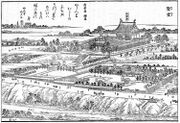

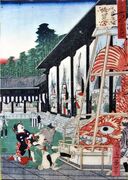
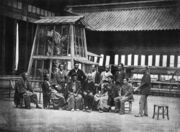


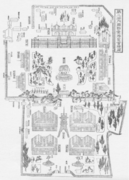

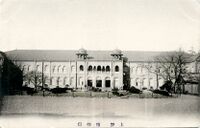
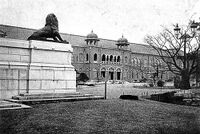
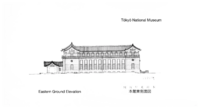




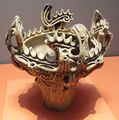



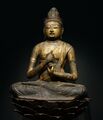





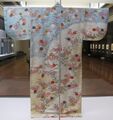

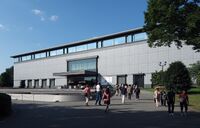
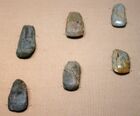
![Incipient Jōmon pottery (radiocarbon dated to 12500 ±350 BP)[25]](/w/images/thumb/9/9f/JomonPottery.JPG/128px-JomonPottery.JPG)
